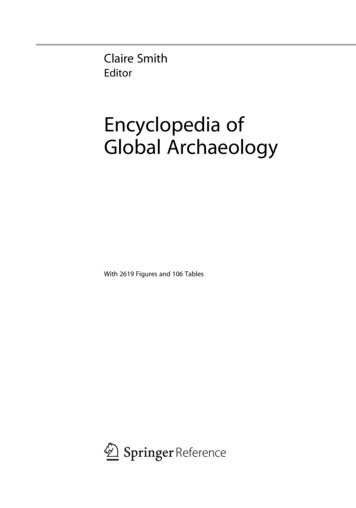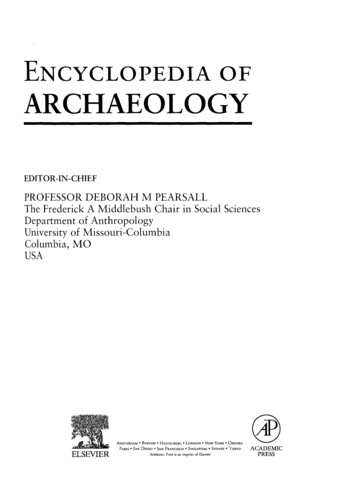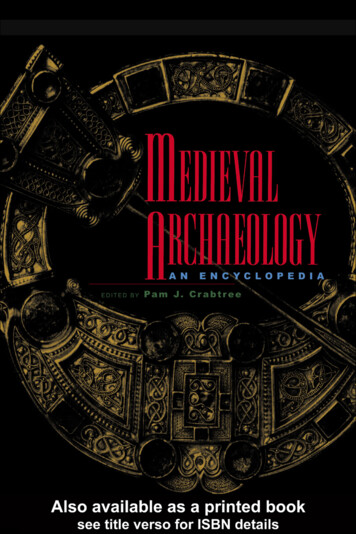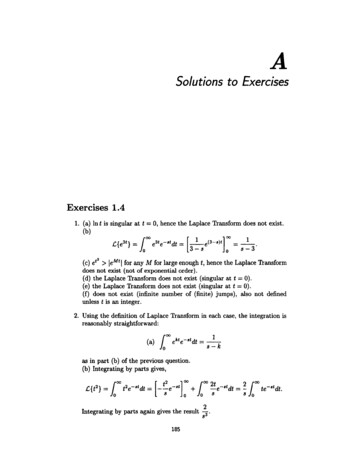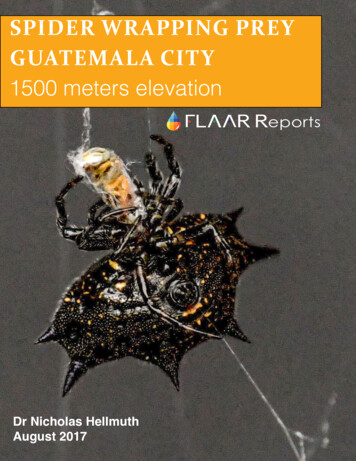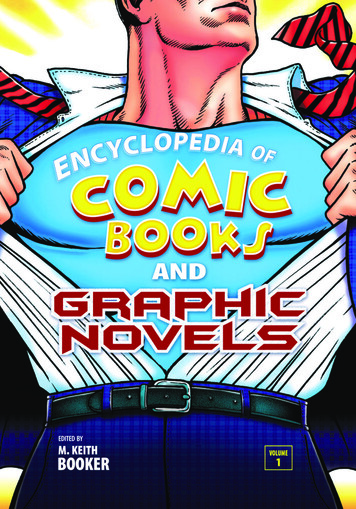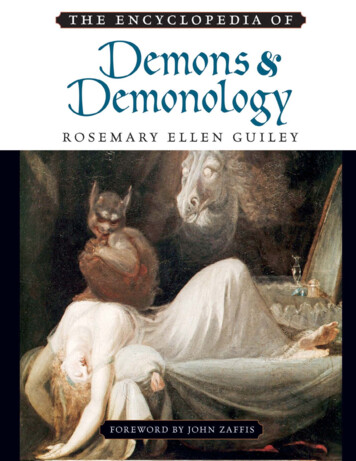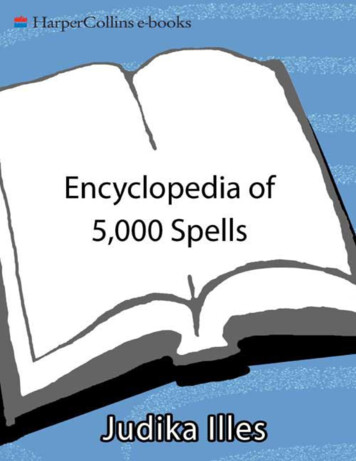
Transcription
Encyclopedia of Global Archaeology
Claire SmithEditorEncyclopedia ofGlobal ArchaeologyWith 2619 Figures and 106 Tables
EditorClaire SmithDepartment of ArchaeologyFlinders UniversityAdelaide, SAAustraliaISBN 978-1-4419-0426-3ISBN 978-1-4419-0465-2 (eBook)ISBN 978-1-4419-0466-9 (print and electronic bundle)DOI 10.1007/978-1-4419-0465-2Springer New York Heidelberg Dordrecht LondonLibrary of Congress Control Number: 2013953915# Springer Science Business Media New York 2014This work is subject to copyright. All rights are reserved by the Publisher, whether the whole orpart of the material is concerned, specifically the rights of translation, reprinting, reuse ofillustrations, recitation, broadcasting, reproduction on microfilms or in any other physical way,and transmission or information storage and retrieval, electronic adaptation, computer software,or by similar or dissimilar methodology now known or hereafter developed. Exempted from thislegal reservation are brief excerpts in connection with reviews or scholarly analysis or materialsupplied specifically for the purpose of being entered and executed on a computer system, forexclusive use by the purchaser of the work. Duplication of this publication or parts thereof ispermitted only under the provisions of the Copyright Law of the Publisher’s location, in itscurrent version, and permission for use must always be obtained from Springer. Permissions foruse may be obtained through RightsLink at the Copyright Clearance Center. Violations are liableto prosecution under the respective Copyright Law.The use of general descriptive names, registered names, trademarks, service marks, etc. in thispublication does not imply, even in the absence of a specific statement, that such names areexempt from the relevant protective laws and regulations and therefore free for general use.While the advice and information in this book are believed to be true and accurate at the date ofpublication, neither the authors nor the editors nor the publisher can accept any legalresponsibility for any errors or omissions that may be made. The publisher makes no warranty,express or implied, with respect to the material contained herein.Printed on acid-free paperSpringer is part of Springer Science Business Media (www.springer.com)
For JackoAlso dedicated toJames Alexander SmithAnnette Pauline Vera SmithCharles Thurstan ShawThomas Walter Willis
PrefaceArchaeology – the study of human cultures through the analysis andinterpretation of artifacts and material remains – continues to captivate andengage people on a local and global level. The significance of such international heritage sites such as the pyramids – both Egyptian and Mayan – theLascaux caves, Stonehenge, and Petra all provide insights into our ancestorsand their actions and motivations. However, there is much more to archaeology than famous sites. When archaeologists are asked to elaborate about theirjob, they will touch on archaeological theory, chemistry, geology, history,classical studies, museum studies, ethical practice, and survey methods, alongwith the analysis and interpretation of their sites. Archaeology is a muchbroader subject than its public image and branches out to many other fields inthe social and hard sciences.The Encyclopedia of Global Archaeology provides a comprehensive andsystematic coverage of archaeology that is unprecedented. It encompasses thebreadth of the subject area along with those aspects that are tapped by otherdisciplines. In addition, it encompasses all time periods and regions of theworld and all stages of human development. The entries range from succinctsummaries of specific sites and the scientific aspects of archaeological enquiry,to detailed discussions of archaeological concepts, theories, and practice, thesocial and political dimensions of archaeology and archaeological ethics. Thedifferent forms of archaeology are explored, along with the techniques used foreach and the challenges, concerns, and issues that face archaeologists today.This 11 volume Encyclopedia of Global Archaeology is available in bothprint and eReference versions. The print version has 1,625 contributions from1,356 authors and over 11,634 cross-references. At the time of publication,another 200 entries have been commissioned for the eReference version.Through constant updating, the eReference version of the Encyclopedia ofGlobal Archaeology will continue to access the best scholarship from aroundthe world. Our aim is to ensure that this reference work will be as useful intwenty years as it is in two years.An Encyclopedia for a Global WorldThe Encyclopedia of Global Archaeology was designed to be a definitivereference work for archaeologists, cultural heritage managers, and the generalpublic. Its major aim is to disseminate global expertise in archaeology.vii
viiiWe have achieved this through four innovations: an unparalleled level ofcontributions from archaeologists who do not normally publish in English,the conscious inclusion of multiple perspectives on key topics, biographies ofmajor archaeological figures from throughout the world, and the combinationof print and continuously up-dated eReference publication.The first major challenge for this encyclopedia was to access the bestscholarship in the world. However, there was a fundamental problem –archaeological experts around the globe do not always write in English. Thebest scholars from throughout the world write in a variety of languages. Forexample, the problems of site conservation and preservation can be verydifferent in different parts of the world – and the experts publish in theirown languages. Moreover, not all specialist knowledge is published inEnglish. Some of the most advanced thinking on archaeological theorycomes from South America, while the French and Spanish have the deepestknowledge of Upper Palaeolithic rock art and the place to learn about largescale urban excavations or historic reconstructions is Japan. The experts fromthese countries publish their research in their own language. While some alsopublish in English, many don’t – and even scholars who speak English can bereluctant to publish in English, as they may not have the level of writtencompetency to fully express the complexity of their ideas.The answer was to allow non-English-language speakers to contribute tothe encyclopedia in their own language. This accessed a torrent of hithertountapped expertise. Around 140 entries and more than 300,000 words in theEncyclopedia of Global Archaeology have been translated from French,Italian, Portuguese, Russian and Spanish. In addition, many more entrieswere submitted by authors whose first language is Chinese, German,Japanese or Turkish. Often, these entries involved significant editing,re-writing, and polishing in order to ensure academic standards and clearcommunication. This painstaking work was undertaken by the editors of therelevant sections and by myself. The authors and translators often had toreview several versions of the text, and they did this without complaint. Thiscooperative and cosmopolitan approach has brought enormous strengths tothe encyclopedia and produced something that is quite different to what hascome before.The second challenge was to maximize the value of the Encyclopedia ofGlobal Archaeology as a teaching resource for schools, colleges, and universities. Some of the best learning is achieved through comparison and debate.Accordingly, we have included multiple and regional perspectives on keytopics to facilitate comparisons, especially at a global level, and provide richmaterials for classroom debates. The ethics of commercial archaeology, forexample, has individual entries that provide perspectives from Australia,Brazil, Japan, Nigeria, Southern Africa and the USA. While each entry provides an in-depth discussion of the issues that affect a particular region, takentogether, these entries provide the materials required for students to undertakeanalyses of contrasts and comparisons at a global level.The third challenge was to honor the work of archaeologists from throughout the world. The biographies in the encyclopedia were selected by sectioneditors on the basis of the contribution of particular archaeologists to specificPreface
Prefaceixdisciplinary areas and also through recommendations from archaeologists inunderrepresented countries. While we attempted to obtain some form ofuniform global coverage in archaeological biographies, this was not possibleas archaeology is at different stages of development in different parts of theworld. The need to build archaeological capacity is greatest on the Africancontinent. The small number of biographies of African archaeologists reflectsthe small number of archaeologists in the continent as a whole. While the vastmajority of these archaeologists are located in South Africa, there are keynodes in countries such as Kenya and Nigeria. Sometimes these nodes are anoutcome of capacity building that occurred as part of colonial processes, aswith the life work of Charles Thurstan Shaw. Some biographies honor thework of archaeologists who spent their lives building capacity in a part of theworld that is not their home country, as with the work of Betty Meggers inSouth America. All of the biographies provide insights into the life historiesof archaeologists in various periods and in diverse parts of the world. Moreover, cultural attitudes are apparent in the profiles of biographies for eachregion. For example, while many Portuguese biographies are of mid-careerarchaeologists who are still alive, the majority of biographies of Japanesearchaeologists are of people who established important facets of the profession and have now passed away.The final challenge was to harness the potential of an online environmentnot only to ensure global accessibility but also to enrich the encyclopedia’scontent. From the beginning, the Encyclopedia of Global Archaeology wasconceived firstly as an online reference work, and then as a print reference.This interactive, online reference uses dynamic content to deepen discussionsand to update material published in the print version, and to add informationon new finds, or new ways of approaching the material. Hot links andextensive cross-references between keywords and related articles providetopics with greater depth and enable efficient searches in a user-friendlymanner. The important innovation here is the continuous updating of entriesand the addition of new entries to the eReference version. This will ensurethat the encyclopedia maintains ongoing relevance.15 July, 2013Professor Claire SmithAdelaide, Australia
AcknowledgmentsMy motivation to produce an encyclopedia originated in my childhood, whenmy mother, Annette Smith, used her hard-won wages to purchase weeklyinstallments of the Columbia Encyclopedia, a one-volume encyclopediaproduced by Columbia University Press. Each week, my sister, Jo, andI would take pleasure in discussing the newest entries with our mother.It was in these conversations that we both learnt a love of scholarship.Decades later, in 2008, the genesis of the Encyclopedia of Global Archaeology arose out of a conversation between Teresa Krauss, a senior editor atSpringer, and myself over lunch at a restaurant in Vancouver. This firstdiscussion was followed by workshops and meetings in Atlanta, Dublin,Memphis, Hawaii, and, regularly, New York. It has taken five years tobring this encyclopedia to fruition.While this encyclopedia is much more than the sum of its parts, each ofthese parts was essential to the final product. There are many people to thank.I am grateful to the individual authors, who have shared their knowledge andexpertise. The vision and architecture of this encyclopedia has been steeredby the International Advisory Board, while the untiring efforts of sectioneditors ensured that high quality and polished entries came in on time.In addition, I thank the members of our editing and production team, whichincludes all of the translators, but especially Lilén Malugani Guillet fromUniversidad Nacional de Catamarca in Argentina; administrative assistant,Cristina Lanteri; in-house editor, Christine Hausmann; and managing editor,Jo Smith. Each person has provided contributions that are essential to thesuccess of the encyclopedia.I thank the following people who helped me to proof read the 8,160 pagesof the Encyclopedia: Heather Burke, Cherrie de Lieuen, Dianne Riley, PetaStraiton, Bradley Guadagnin, Chelsea Colwell-Pasch and Vanessa Sullivan.Those who seek insight into the role of the editor should look up theYouTube clipping “C is for Contrafibularity,” from the BBC programBlackadder, in which the writer Samuel Johnson celebrates having completedhis lifework of a dictionary with every word in the English language – only tobe accosted by a host of new words. Like the English language, archaeology isconstantly changing and growing. While this is the most globally comprehensive encyclopedia of archaeology produced to date, it is not possible tohave an entry on every possible subject. People should use this encyclopediaas a first stop for obtaining information on a topic and as a directory to furtherxi
xiiAcknowledgmentsspecialist information. Those seeking greater knowledge on a specific topicshould use the reading lists provided to identify specialist publications.Readers should be prepared for some of these readings to be in a languageother than English.The translated entries, which are a critical and definitive characteristic ofthis encyclopedia, have been made possible through support from SpringerVerlag and through two grants from Flinders University in South Australia,one from the Faculty of Education, Humanities and Law and one from theSchool of Humanity. This support has allowed the encyclopedia to contributeto the democratization of archaeology globally. By accessing the work ofthe finest scholars, no matter what langua
15.07.2013 · Preface. Archaeology – the study of human cultures through the analysis and interpretation of artifacts and material remains – continues to captivate and engage people on a local and global level. The significance of such interna- tional heritage sites such as the pyramids – both Egyptian and Mayan – the Lascaux caves, Stonehenge, and Petra all .
